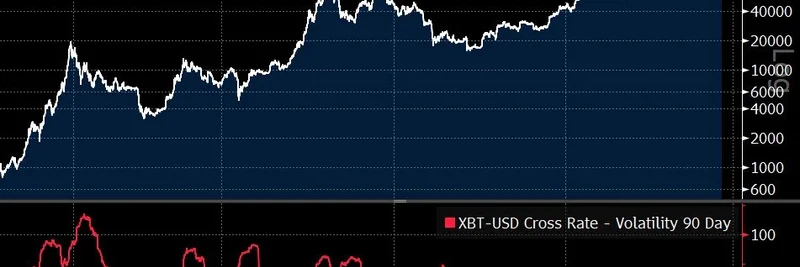Joe McCann, founder and CEO of Asymmetric Financial, recently dropped a thought-provoking tweet that's stirring up discussions in the crypto community. He points out that Bitcoin's volatility is experiencing a long-term downward trend—what experts call a secular decline—and it's essentially in a bear market for volatility. This shift, he argues, is a direct result of Bitcoin becoming "institutionalized." Let's unpack this and see what it means for the world of meme tokens and beyond.
Understanding Bitcoin's Volatility Shift
Volatility measures how much an asset's price swings over time. For Bitcoin, those wild price fluctuations have been part of its charm—and its risk. But as the chart in McCann's tweet illustrates, the 90-day volatility has been trending downward since around 2018, even as Bitcoin's price has climbed overall. We're talking bouts of extremely low volatility that often precede major moves, but the overall pattern is one of stabilization.
A "secular decline" isn't just a temporary dip; it's a fundamental, long-lasting change. Think of it like Bitcoin growing up—from a rebellious teenager in the crypto wild west to a more predictable adult in the financial mainstream. And the "severe bear market" for volatility? That means the days of 100%+ swings in short periods are becoming rarer, much like how stock markets behave during calm times.
The Role of Institutionalization
McCann nails it: this is what happens when big players enter the scene. Institutionalization refers to traditional finance giants—think hedge funds, banks, and ETFs—pouring money into Bitcoin. Spot Bitcoin ETFs, approved by the SEC in early 2024, have been a game-changer. Firms like BlackRock and Fidelity now hold billions in BTC, providing easier access for everyday investors without the hassle of self-custody.
This influx stabilizes prices because institutions trade differently. They're not panic-selling on memes or hype; they use sophisticated strategies, derivatives, and long-term holds. As a result, Bitcoin starts behaving more like gold or blue-chip stocks—less volatile, more predictable. But is this good or bad? It depends on your perspective. For long-term holders, lower volatility means less stress. For thrill-seekers, it might signal the end of the "get rich quick" era.
Implications for Meme Tokens
At Meme Insider, we're all about meme tokens—the fun, community-driven side of crypto. So, how does Bitcoin's maturation affect them? Meme coins like Dogecoin or newer Solana-based tokens thrive on volatility. They're fueled by retail investors, viral trends, and social media buzz, not institutional money. In fact, as Bitcoin calms down, capital might flow into riskier assets like memes for those seeking higher returns.
But there's a flip side. If institutions dominate Bitcoin, they could influence the entire market. Regulatory pressures might trickle down, making it harder for meme projects to launch without compliance hurdles. On the bright side, a stable Bitcoin could serve as a "safe haven" in crypto, allowing meme tokens to experiment without dragging the whole ecosystem down in crashes.
We've seen this pattern before. Gold's volatility dropped after ETFs were introduced in the 2000s, centralizing supply but boosting adoption. Bitcoin might follow suit, potentially hitting new highs with less drama. For meme token enthusiasts, this could mean more opportunities in privacy-focused or decentralized alternatives that sidestep institutional control—think coins emphasizing PvE (player versus environment) dynamics where individuals benefit directly.
Looking Ahead in the Crypto Landscape
As blockchain technology evolves, understanding these shifts is key for practitioners. If you're building or investing in meme tokens, keep an eye on volatility metrics. Tools like TradingView or CoinMarketCap can help track these trends. And remember, while institutionalization might tame Bitcoin, the spirit of crypto—decentralization and innovation—lives on in communities driving meme culture.
What do you think? Is Bitcoin's low volatility a sign of strength or the beginning of its "boring" phase? Drop your thoughts in the comments, and stay tuned to Meme Insider for more insights on the latest in meme tokens and blockchain news.



